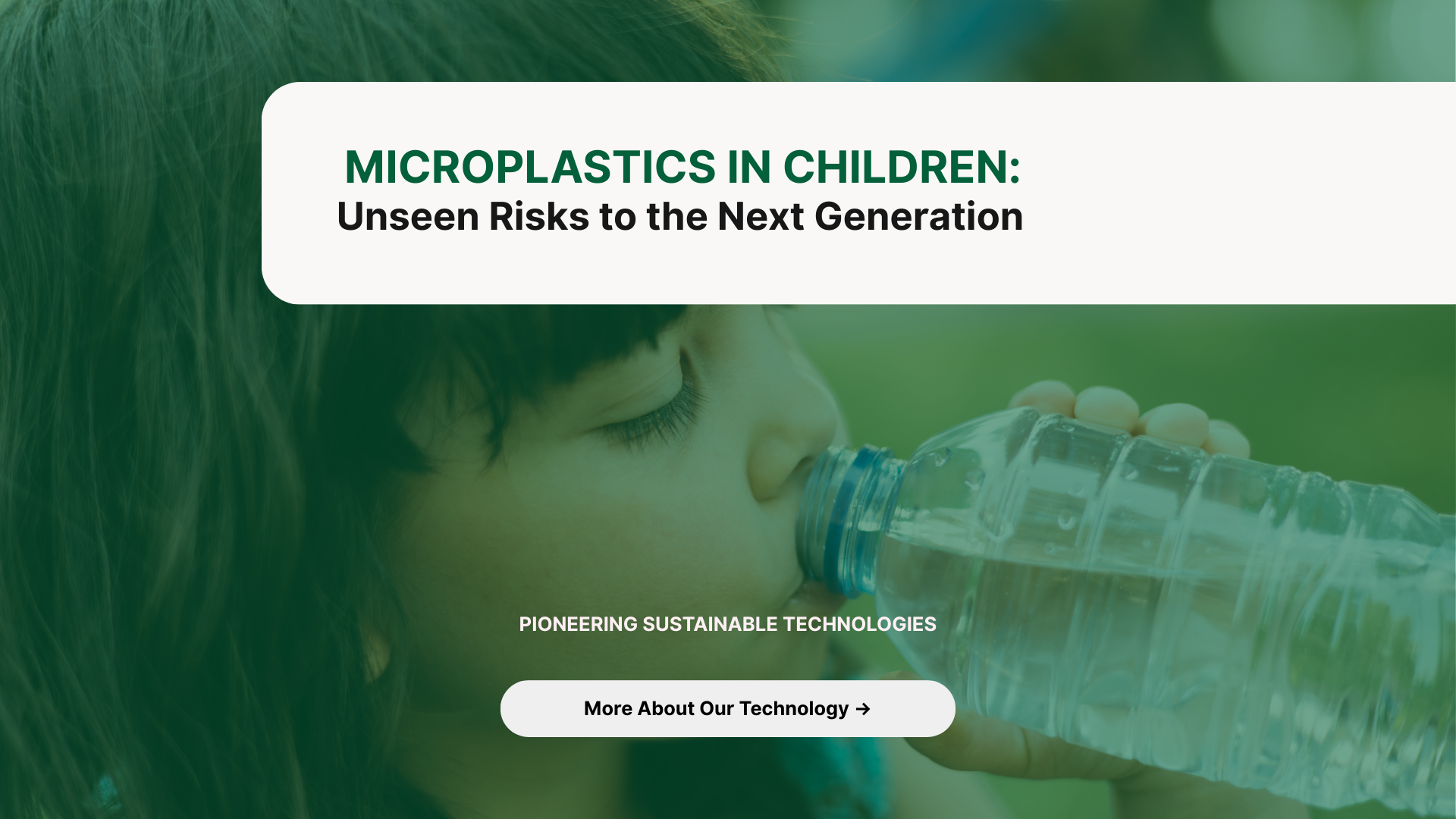The presence of microplastics in children’s bodies is no longer speculation. Recent studies have confirmed that plastic particles are entering the most vulnerable populations through food, air, and water. The implications are not yet fully understood, but the scientific community is raising alarms over developmental, immunological, and neurological consequences.
With plastic production expected to triple by 2060, the risks are no longer distant. This article breaks down how exposure happens, what the science reveals about its impact on children, and why urgent policy and product changes are needed to protect the next generation.
How Microplastics Reach Children
Microplastics are defined as plastic particles smaller than 5 millimetres. Nanoplastics are even smaller, often less than 0.001 millimetres in size, and are capable of penetrating cell membranes and crossing the blood-brain barrier.
Children are exposed through several pathways:
- Drinking water, particularly bottled water
- Breathing indoor air, which contains microfibres from synthetic clothing, furniture, and carpets
- Eating processed foods and seafood, especially shellfish and fish that accumulate plastic in tissues
- Using baby products, including feeding bottles, toys, and packaging made with plastic compounds
- Contact with household dust, which has been shown to contain high concentrations of microplastics
Due to their faster metabolisms, developing organs, and higher intake of air, food, and water per kilogram of body weight, children are more biologically susceptible than adults to chemical exposure from plastic materials.
What Science Says About Microplastics in Children’s Health
A 2023 study by the University of Hull found microplastics in the blood of more than 75 percent of the child participants aged 3 to 12. The particles were linked to packaging materials, synthetic textiles, and contaminated water. In a separate 2024 paper published in the journal Toxics, researchers found nanoplastics in the placentas and meconium of newborns, suggesting exposure starts in the womb.
Studies have linked microplastic exposure in children to:
- Inflammation of lung and gut tissue
- Immune system dysregulation, potentially leading to allergies and autoimmune conditions
- Endocrine disruption, affecting hormonal development and growth
- Changes in the gut microbiome, impacting digestion and long-term immunity
- Increased permeability of the blood-brain barrier, with unknown neurological outcomes
Microplastics are not inert. They often carry plasticisers, heavy metals, flame retardants, and other chemical additives, which can leach into surrounding tissues. They also adsorb environmental pollutants like pesticides and persistent organic pollutants (POPs), further compounding toxicity.
Bottled Water: A Major Source of Microplastic Exposure
According to the National Institutes of Health, a litre of bottled water contains an average of 240,000 detectable plastic particles, most of them in the nanoplastic range. This makes bottled water one of the most concentrated daily sources of plastic ingestion for children and adults alike.
Plastic particles from bottle degradation, caps, and production processes are small enough to bypass filtration and are not removed during standard bottling. Once ingested, these nanoplastics can translocate to vital organs and tissues.
In children, the immune system is still maturing. The ingestion of plastic particles and their associated chemical load may interfere with immune programming, increase inflammation, and alter long-term health outcomes.
Health Agencies Are Beginning to Respond
The World Health Organization updated its position in 2024, warning that microplastic exposure could pose a serious health risk, particularly for infants and children. Although definitive long-term data is still being gathered, the WHO called for urgent reduction in plastic use, more transparent product labelling, and strict regulation of plastic in food and water contact applications.
The European Food Safety Authority (EFSA) has also launched a comprehensive review of food packaging and beverage containers, citing nanoplastics as a top emerging risk to child health. In Australia, however, regulations on microplastics in consumer goods remain limited and lack national enforcement.
The Role of Product Design and Biodegradable Packaging
Reducing microplastic exposure at the source is the most effective strategy. Biodegradable alternatives to conventional plastic bottles and containers are now available and independently verified.
The Greener Tech Group’s Eco Bottle offers one such solution. It is:
- 100 percent biodegradable
- Free from fossil-based polymers
- Certified to break down fully in landfill
- Non-toxic, with no microplastic residue
- Safe for contact with drinking water and food
Unlike traditional “bioplastics” that often degrade into microplastic fragments, The Eco Bottle uses a depolymerisation additive that enables full breakdown into organic compounds without leaching chemicals or releasing harmful gases. This technology supports a safer environment and significantly reduces the risk of microplastic exposure in children and families.
Education and Consumer Awareness Are Crucial
Parents, schools, and health professionals need better information on how plastic exposure occurs. Raising awareness about:
- The risks of microwaving plastic containers
- The difference between biodegradable and compostable
- The hidden plastic in clothes, cleaning products, and toys
This knowledge can shift consumer behaviour, especially when backed by clear labelling and verified third-party certifications.
Parents can begin to reduce exposure by:
- Choosing glass or certified biodegradable bottles for their children
- Avoiding plastic food containers for reheating meals
- Using HEPA filters in vacuum cleaners to reduce airborne plastic fibres
- Encouraging school programs to teach about plastic, pollution, and health
From Prevention to Protection: Industry and Policy Must Lead
While individual action is important, systemic change is essential. The path forward includes:
- National legislation banning microplastics in packaging and food contact materials
- Public funding for research into child-specific health impacts
- Adoption of certified biodegradable alternatives in schools, hospitals, and childcare centres
- Pressure on beverage and toy manufacturers to eliminate fossil-based plastic in all products aimed at children
Investors are also playing a role. ESG frameworks now factor in microplastic exposure as a material risk. Companies failing to address it may see declining social scores and loss of consumer trust.
The Next Generation Deserves Better
Children today are born into a plastic-saturated world. From the womb to their first sip of water, they are surrounded by materials never intended to be part of the human body. The scientific data is growing. The health risks are real. The technologies to reduce those risks already exist.
Protecting the next generation requires more than awareness. It demands that sustainable product design, rigorous regulation, and evidence-based public health policies become the new standard.
Key Summary
✓ Microplastics are found in children’s blood, placentas, and daily environments
✓ Exposure happens through bottled water, indoor air, food, dust, and baby products
✓ Health risks include immune dysfunction, hormone disruption, and inflammation
✓ Bottled water contains up to 240,000 plastic particles per litre, mostly nanoplastics
✓ Biodegradable packaging like Eco Bottle eliminates microplastic exposure at the source
✓ WHO and EFSA are warning regulators to act, but Australian standards remain weak
✓ Reducing child exposure requires safer products, public education, and stronger policy
References:
- World Health Organization. (2019). Microplastics in Drinking Water: Updated Advisory.
Learn More: https://www.who.int/news/item/20-08-2019-microplastics-in-drinking-water - National Institutes of Health. (2024).Understanding Exposures to Microplastics and Nanoplastics.
Learn More: https://www.niehs.nih.gov/research/supported/translational/peph/podcasts/2024/sep24_exposures-microplastics - Toxics Journal. (2025). The Silent Conquest: The Journey of Micro- and Nanoplastics Through Children’s Organs.
Learn More: https://www.mdpi.com/3514244

